View in other NatureServe Network Field Guides
NatureServe
Montana
Utah
Wyoming
Idaho
Wisconsin
British Columbia
South Carolina
Yukon
California
New York
A Tortella Moss - Tortula hoppeana
Other Names:
Desmatodon latifolius
General Description
Plants: Acrocarpous (Vitt 1988). Shoots growing upright and in clumps or scattered (Lawton 1971), not shiny (Crum & Anderson et al. 1981), green above, with shades of brown below (FNA 2007). Stems 2-20 mm tall (Flowers 1973), sometimes forked, possessing a central strand; axillary hairs to 8 cells long, the distal cells with thinner walls (FNA 2007).
Leaves: Upright against the stem and infolded when dry, spreading slightly to broadly when wet, egg-shaped (FNA 2007) to spathulate (Flowers 1973), with the apex nearly obtuse and sometimes rounded (FNA 2007), 1.5-3 mm in length, 0.6-0.8 mm in width (Lawton 1971); margins curved back and down in the middle part of the leaf, wavy near the apex (FNA 2007) and smooth proximally; costa narrowing distally, extending beyond the leaf tip and forming a mucro or hair-point in the distal leaves, frequently subpercurrent in the proximal leaves with the laminal cells then sometimes creating the mucro (Flowers 1973), or some leaves muticous (FNA 2007).
Leaf Cells: Basal cells quadrangular with thin, transparent walls; upper laminal cells 1:1, 6-sided, thickly covered with papillae, the papillae sometimes 2-lobed; leaf edges unbordered or faintly bordered with diamond-shaped cells, the cells smaller and with fewer papillae than adjacent cells; mucro of long, clear cells; costa in X-section convex on the ventral surface, with a ventral epidermis (FNA 2007), sub-ventral guide cells (usually in 1 row) (Flowers 1973), hydroid strand, a strong semi-circular dorsal stereid band, and a dorsal epidermis (FNA 2007) of cells somewhat larger than the adjacent stereids (Flowers 1973).
Phenology
Phenology: Fruit ripens in summer (FNA 2007).
Diagnostic Characteristics
Laminal cells thickly covered with 2-lobed papillae, and the wavy apical margin leading to the usually long mucro (some leaves lacking a mucro) with long, clear cells are characteristic (FNA 2007).
Range Comments
North American Range
Western region of Canada and the United States, from NT sw to NM, west to the Pacific Coast states, also QC, NL, and MI (FNA 2007). Known in Montana from Cascade, Flathead, Glacier, Hill, Jefferson, Lake, Lincoln, Powder River, and Sweet Grass Counties (Elliott 2016).
Observations in Montana Natural Heritage Program Database
Number of Observations: 53
(Click on the following maps and charts to see full sized version)
Map Help and Descriptions
Relative Density
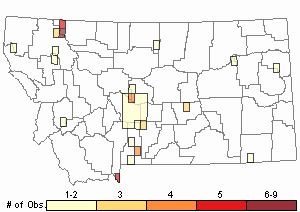
Recency
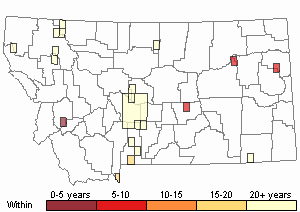
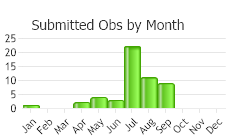
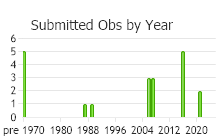
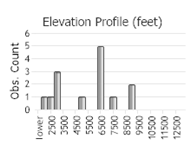 (Observations spanning multiple months or years are excluded from time charts)
(Observations spanning multiple months or years are excluded from time charts)
Habitat
Soil, sometimes calcareous (FNA 2007), sometimes on soil in stone fissures (Crum & Anderson et al. 1981); montane (Lawton 1971) to alpine and in tundra (FNA 2007).
Reproductive Characteristics
Autoicous (FNA 2007), but plants frequently only producing either male or female gametangia (Lawton 1971). Seta 9-19 mm tall. Capsule brownish, upright, scarcely curved, carried fully beyond the perichaetial leaves; theca 1.5-2.8 mm in length (FNA 2007); operculum with a tilted beak (Crum & Anderson et al. 1981); peristome sections 16, seldom spiraled, split nearly the full length or just below, frequently united in 2’s or larger groups. Calyptra hood-like (FNA 2007).
Stewardship Responsibility
References
- Literature Cited AboveLegend:
 View Online Publication
View Online Publication Crum, H.A. and L.E. Anderson. 1981. Mosses of Eastern North America. 2 volumes. Columbia University Press, New York. 1328 pp.
Crum, H.A. and L.E. Anderson. 1981. Mosses of Eastern North America. 2 volumes. Columbia University Press, New York. 1328 pp. Elliott, J.C. and A.K. Pipp. 2018. A Checklist of Montana Mosses (1880-2018). Updated 3 January, 2020. Montana Natural Heritage Program, Helena, Montana. 73 pp.
Elliott, J.C. and A.K. Pipp. 2018. A Checklist of Montana Mosses (1880-2018). Updated 3 January, 2020. Montana Natural Heritage Program, Helena, Montana. 73 pp. Flora of North America Editorial Committee, eds. 2007. Flora of North America North of Mexico. Volume 27. Bryophytes: Mosses, Part 1. Oxford University Press, Inc., NY. xxi + 713 pp.
Flora of North America Editorial Committee, eds. 2007. Flora of North America North of Mexico. Volume 27. Bryophytes: Mosses, Part 1. Oxford University Press, Inc., NY. xxi + 713 pp. Flowers, S. 1973. Mosses: Utah and the West. Brigham Young University, Provo, Utah. 567 p.
Flowers, S. 1973. Mosses: Utah and the West. Brigham Young University, Provo, Utah. 567 p. Lawton, E. 1971. Moss Flora of the Pacific Northwest. Hattori Botanical Laboratory. Japan: Yamabuki-cho, Shinjuku-ku, Tokyo. 362 pages plus appendices.
Lawton, E. 1971. Moss Flora of the Pacific Northwest. Hattori Botanical Laboratory. Japan: Yamabuki-cho, Shinjuku-ku, Tokyo. 362 pages plus appendices. Vitt, D. J. Marsh, and R. Bovey. 1988. Mosses, Lichens & Ferns of Northwest North America. Seattle, WA: University of Washington Press. 296 p.
Vitt, D. J. Marsh, and R. Bovey. 1988. Mosses, Lichens & Ferns of Northwest North America. Seattle, WA: University of Washington Press. 296 p.
- Additional ReferencesLegend:
 View Online Publication
View Online Publication
Do you know of a citation we're missing? Aho, Ken Andrew. 2006. Alpine and Cliff Ecosystems in the North-Central Rocky Mountains. Ph.D. Dissertation. Bozeman, Montana: Montana State University. 343 p.
Aho, Ken Andrew. 2006. Alpine and Cliff Ecosystems in the North-Central Rocky Mountains. Ph.D. Dissertation. Bozeman, Montana: Montana State University. 343 p. Elliot, J. C. 1993. Second checklist of Montana mosses. Unpublished report. U.S. Forest Service, Region 1. Missoula, MT. 45 pp.
Elliot, J. C. 1993. Second checklist of Montana mosses. Unpublished report. U.S. Forest Service, Region 1. Missoula, MT. 45 pp. Lawton, E. 1971. Keys for the Identification of the Mosses on the Pacific Northwest. Reprinted from 'Moss Flora of the Pacific Northwest'. Published as Supplement No. 2 of the Journal of the Hattori Botanical Laboratory. Nichinan, Miyazaki, Japan. 66 pp.
Lawton, E. 1971. Keys for the Identification of the Mosses on the Pacific Northwest. Reprinted from 'Moss Flora of the Pacific Northwest'. Published as Supplement No. 2 of the Journal of the Hattori Botanical Laboratory. Nichinan, Miyazaki, Japan. 66 pp. Malcolm, B., N. Malcolm, J. Shevock, and D. Norris. 2009. California Mosses. Nelson, New Zealand: Micro-Optics Press. 430 pp.
Malcolm, B., N. Malcolm, J. Shevock, and D. Norris. 2009. California Mosses. Nelson, New Zealand: Micro-Optics Press. 430 pp.
- Web Search Engines for Articles on "A Tortella Moss"





